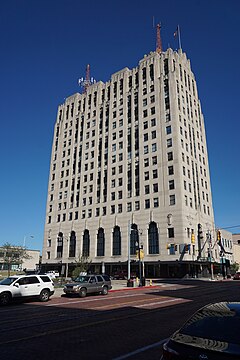
Flint is the largest city and seat of Genesee County, Michigan, United States. Located along the Flint River, 66 miles (106 km) northwest of Detroit, it is a principal city within the region known as Mid Michigan. According to the 2020 census, Flint has a population of 94,762, making it the seventh largest city in Michigan. The Flint metropolitan area is located entirely within Genesee County. It is the fourth largest metropolitan area in Michigan with a population of 406,892 in 2020. The city was incorporated in 1855.

Genesee County is a county in the U.S. state of Michigan. As of the 2010 census, the population was 425,790, making it the fifth-most populous county in Michigan. The county seat and population center is Flint. Genesee County is considered to be a part of the greater Mid Michigan area.
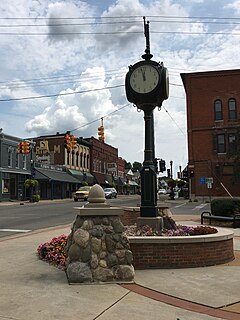
Flushing is a city in Genesee County in the U.S. state of Michigan. The population was 8,389 at the 2010 census. Flushing is considered a suburb of Flint. It is situated within the survey area of Flushing Charter Township, but is administratively autonomous.

Charles Stewart Mott was an American industrialist and businessman, a co-founder of General Motors, philanthropist, and the 50th and 55th mayor of Flint, Michigan.
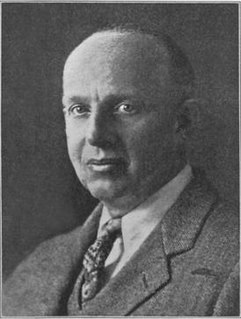
Wirt Clinton Rowland was an American architect best known for his work in Detroit, Michigan.

The Flint Journal is a quad-weekly newspaper based in Flint, Michigan, owned by Booth Newspapers, a subsidiary of Advance Publications. Published Tuesdays, Thursdays, Fridays and Sundays, it serves Genesee, Lapeer and Shiawassee Counties. As of February 2, 2012, it is headquartered in Downtown Flint at 540 S Saginaw St, Suite 504. The paper and its sister publications The Saginaw News and The Bay City Times are printed at the Booth-owned Valley Publishing Co. printing plant in Monitor Township.
The Charles Stewart Mott Foundation is a private foundation founded in 1926 by Charles Stewart Mott of Flint, Michigan. Mott was a leading industrialist in Flint through his association with General Motors.

The Flint River is a 78.3-mile-long (126.0 km) river in the Flint/Tri-Cities region of Michigan in the United States. The river's headwaters are in Columbiaville in Lapeer County and flows through the counties of Lapeer, Genesee, and Saginaw. The cities of Lapeer, Flint, Flushing, and Montrose are along its course.

The Genesee Towers was the tallest building in Flint, Michigan, United States. It was demolished on December 22, 2013 after a period of inactivity and loss of occupancy.
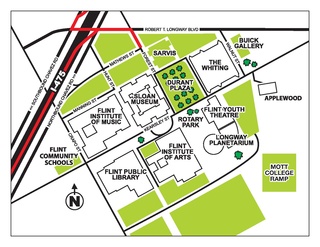
The Flint Cultural Center (FCC) is a campus of cultural, scientific, and artistic institutes located in Flint, Michigan, United States. The institutions located on the grounds of the FCC are the Flint Institute of Arts, Flint Institute of Music, Sloan Museum, Flint Public Library, Buick Gallery & Research Center, Robert T. Longway Planetarium, The Whiting, and the Bower Theatre. The campus and some institutions are owned by Flint Cultural Center Corporation.

Central Michigan, also called Mid Michigan, is a region in the Lower Peninsula of the U.S. state of Michigan. As its name implies, it is the middle area of the Lower Peninsula. Lower Michigan is said to resemble a mitten, and Mid Michigan corresponds roughly to the thumb and palm, stretching from Michigan's eastern shoreline along Lake Huron into the fertile rolling plains of the Michigan Basin. The region contains cities of moderate size, including Flint, Saginaw, and the state capital of Lansing.
Mott Community College is a public community college in Flint, Michigan. It is named for politician, businessman, and philanthropist Charles Stewart Mott. Its district is the same as the Genesee Intermediate School District and is governed by an elected board of trustees. The college offers 61 associate degrees and 40 pre-associate certificates. It also has satellite campuses in nearby Clio, Fenton, Lapeer, and Howell. The majority of students come from Genesee, Lapeer, and northwest Oakland County.

DocuSign Tower, previously the Wells Fargo Center, is a skyscraper in Seattle, in the U.S. state of Washington. Originally named First Interstate Center when completed in 1983, the 47-story, 574-foot (175 m) tower is now the ninth-tallest building in the city, and has 24 elevators and 941,000 square feet (87,400 m2) of rentable space. The design work was done by The McKinley Architects, and it was owned by Chicago-based EQ Office.
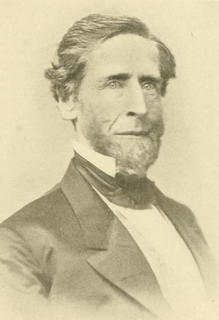
James B. Walker (1812–1877) was a Michigan politician.
Union Trust and Savings Bank was a bank that served the City of Flint, Michigan. It was established in 1893, merged in 1929 and failed during the Great Depression.
National Bank of Flint was a bank headquartered in Flint, Michigan. In 1942, it was acquired by Michigan National Bank.

The Northbank Center, formerly known as the Industrial Savings Bank Building, is an office and educational building located at 432 North Saginaw Street in Flint, Michigan. The building is now part of University of Michigan–Flint. It was listed on the National Register of Historic Places in 1984.
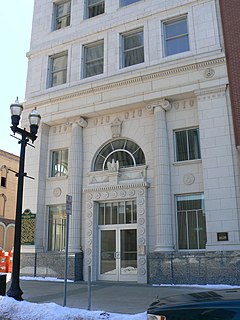
The First Street Lofts is a converted office building located at 460 South Saginaw Street in Flint, Michigan. It was listed on the National Register of Historic Places in 2007.

The Genesee County Savings Bank is an office building located at 352 South Saginaw Street in Flint, Michigan. It was listed on the National Register of Historic Places in 2017.
Crossroads Village is a living history museum in Genesee County, Michigan, near Flint. It is operated by the Genesee County Parks and Recreation Commission alongside the Huckleberry Railroad. Initially proposed as a Flint River recreational area and a farm museum, it was opened as a historical village in 1976.
